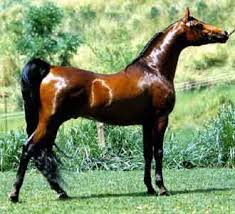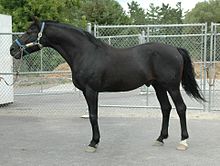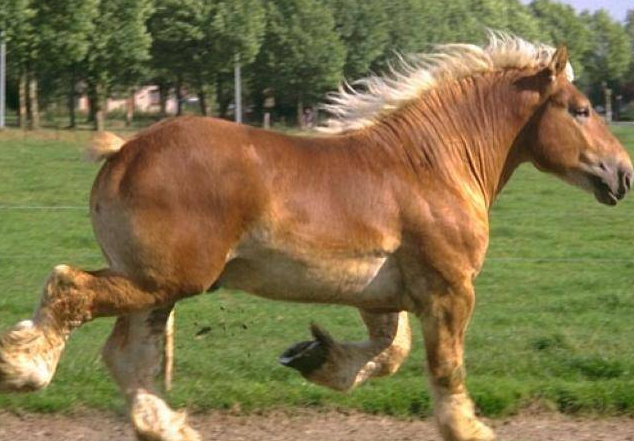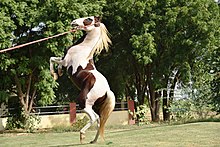Marvarian horse (part 1)
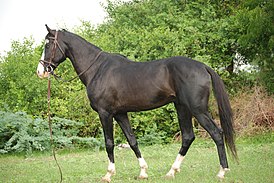 The Marwar horse (Marvari), or Malani, is a rare breed of horse from Marwar, a region in India. Known for its exotic ear shape. They are known for their stamina and are quite similar to kathiyavari, another Indian breed from Kathiyavar. Marwari came from crossing local Indian ponies with an Arabian horse, possibly with some influence from Mongolian horses.
The Marwar horse (Marvari), or Malani, is a rare breed of horse from Marwar, a region in India. Known for its exotic ear shape. They are known for their stamina and are quite similar to kathiyavari, another Indian breed from Kathiyavar. Marwari came from crossing local Indian ponies with an Arabian horse, possibly with some influence from Mongolian horses.
The Rathors, the traditional rulers of Marwar, were the first to start breeding Marwar. Starting from the 12th century, they strictly selected horses for breeding, which contributed to the purity of blood and endurance. Used throughout history as the cavalry horses of the Marwar people, they have been noted as loyal and brave in battle. The breed deteriorated in the 1930s when poor management practices led to a reduction in livestock numbers, but today they have been restored again. Marvari was banned for decades, but between 2000 and 2006 a small amount was allowed. An exception was made for the American Francesca Kelly, who became the organizer of the Indigenous Horse Society of India [1]. Since 2008, visas allowing the exit of the marvari outside of India have been available in small quantities.
Breed history
Marwari are descended from local Indian ponies and Arabian horses. The ponies were small and hardy, but with a poor configuration. The influence of Arab blood improved the appearance without compromising winter hardiness. Indian legends say an Arab ship with seven thoroughbred Arabian horses was wrecked off the coast of Kach County. Then these horses were caught in the Marwar area and became the founders of the breed. There is also the possibility of the influence of Mongolian horses from the north. The breed was most likely formed in northwestern India on the border with Afghanistan, as well as with Uzbekistan, Kazakhstan and Turkmenistan.
The rulers of Marwar and the cavalry of Rajput were traditional Marvari breeders. Rathors were expelled from their kingdom Kanauj in 1193 and retired to the Great Indian and Tara deserts. Marvari were vital for their survival, and during the 12th century their breeding was carried out under strict control. Breeders kept the best stallions for insemination. During this time, horses were considered divine beings, and during this time only members of the Rajput families and the caste of Kshatriya warriors were allowed to ride them. When the Moguls captured northern India at the beginning of the 16th century, they brought Turkmen horses, which were probably used as a supplement in the breeding of Marwari. Marvari were known during this period for their courage and courage in battle, as well as for their loyalty to their riders. At the end of the 16th century, the Rajputs of Marwar, led by the Mogul emperor Akbar, formed cavalry troops of more than 50,000 troops. The Rathors believed that a Marvari horse could leave the battlefield only under one of three conditions – victory, death, or carrying a wounded rider to a safe place. Extreme responsiveness was brought up in horses in battlefield conditions, and they practiced difficult riding maneuvers.
Marvar horse in a candle
The period of British rule led to the fall of Marwari as a breed and cult. The British invaders preferred other breeds and tried to destroy the Marvari along with Kathiyavari. Instead, the British preferred purebreds and polo-ponies and lowered Marvari’s reputation to such an extent that even the inward-looking ears of the breed were ridiculed as a “sign of a local horse.” In the 1930s, the Marvari worsened, livestock decreased and became of poorer quality due to poor breeding practices. The independence of India, along with the obsolescence of equestrian warriors, reduced the need for Marwari, and many animals were subsequently killed. In the 1950s, many Indian nobles lost their land and, therefore, most of their ability to care for animals, as a result of which many Marvari horses were sold as pack animals, were castrated or killed. The breed was on the verge of extinction until the intervention of Maharaja Umaid Singhji in the first half of the 20th century saved Marvari. His work was continued by his grandson, Maharaja Gaj Singh II.
A British rider named Francesca Kelly founded a group called Marwari Bloodlines in 1995 with the goal of popularizing and preserving the Marvari horse around the world. In 1999, Kelly and Raghuvendra Singh Dundlod, a descendant of the Indian nobility, led the group that founded the Indigenous Horses Society of India (which includes the Marvari Horse Society), a group that works with the government, breeders and the public, to promote and preserve the breed. Kelly and Dunlod also took part and won endurance races at Indian National Equestrian Games, persuading the Indian Equestrian Federation to authorize a national show for places
